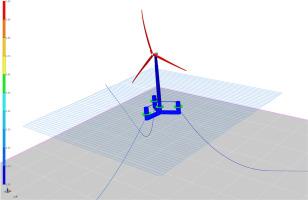Power performance and dynamic characteristics of a 15 MW floating wind turbine with wave energy converter combined concept
引用次数: 0
Abstract
Recently, the large-scale development of Floating Offshore Wind Turbines (FOWTs) has raised attention to efficient energy capture and conversion. Combining a wave energy generator with a wind turbine system enhances the overall power production and reduces operating costs, effectively lowering the Levelized Cost of Electricity (LCoE). This work proposes a novel combined wind-wave energy generation concept consisting of a 15 MW class semi-submersible FOWT and four heaving-type torus-shape Wave Energy Converters (WECs) integrated with the platform columns. A fully coupled numerical model of aero-hydro-elastic-servo-mooring is developed based on the SIMO-RIFLEX framework. The power performance and dynamic response of the combined concept are statistically and analytically investigated by time-domain simulation for several sets of working load cases. The results show that introducing tori will bring additional restoring moments and damping effects to the platform, contributing to stable motion. In the rated operating condition, the pitch amplitude of the combined concept is 31.5 % less than that of the FOWT. At the same time, the torus-shaped WECs hardly affect the power performance of the wind turbine. The combined concept provides an additional contribution of wave energy, which is about 11.4 % of the annual power production in the rated operating case. Regarding dynamic characteristics, the combined concept exhibits a greater sensitivity to wave excitation.

15 兆瓦浮动风力涡轮机与波浪能转换器组合概念的功率性能和动态特性
最近,浮式海上风力涡轮机(FOWTs)的大规模开发引起了人们对高效能源捕获和转换的关注。将波浪能发电机与风力涡轮机系统相结合,可提高整体发电量并降低运营成本,从而有效降低平准化电力成本(LCoE)。本研究提出了一种新颖的风能-波浪能联合发电概念,包括一个 15 兆瓦级半潜式 FOWT 和四个与平台支柱集成的重型环形波浪能转换器(WECs)。在 SIMO-RIFLEX 框架的基础上,开发了一个气动-水动-弹性-伺服-锚定的全耦合数值模型。通过对几组工作负载情况进行时域仿真,对组合概念的动力性能和动态响应进行了统计和分析研究。结果表明,引入 Tori 将为平台带来额外的恢复力矩和阻尼效应,有助于实现稳定的运动。在额定工作条件下,组合概念的俯仰振幅比 FOWT 小 31.5%。同时,环形风电机组几乎不会影响风力涡轮机的功率性能。在额定运行情况下,组合概念提供了额外的波浪能贡献,约占年发电量的 11.4%。在动态特性方面,组合概念对波浪激励的敏感性更高。
本文章由计算机程序翻译,如有差异,请以英文原文为准。
求助全文
约1分钟内获得全文
求助全文

 求助内容:
求助内容: 应助结果提醒方式:
应助结果提醒方式:


